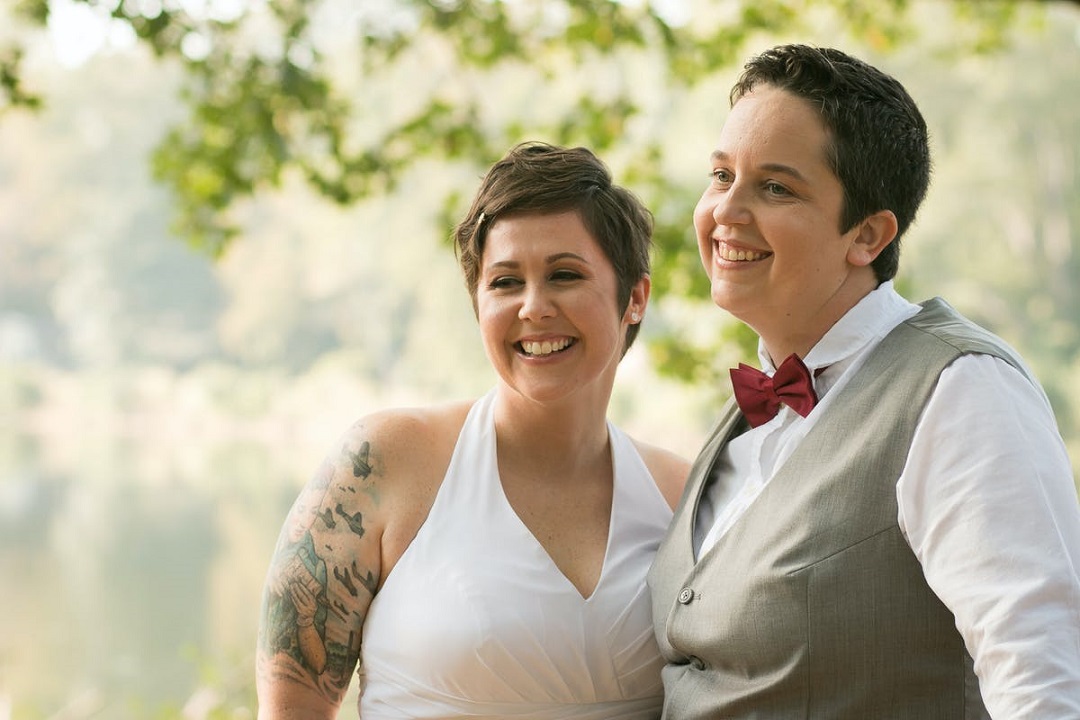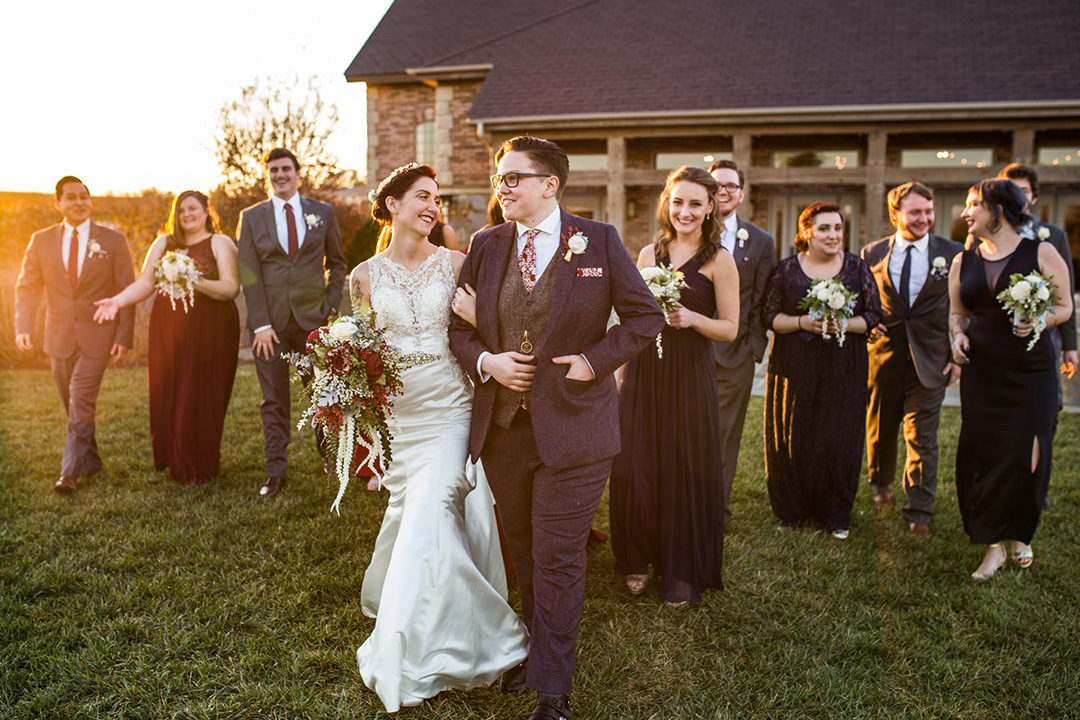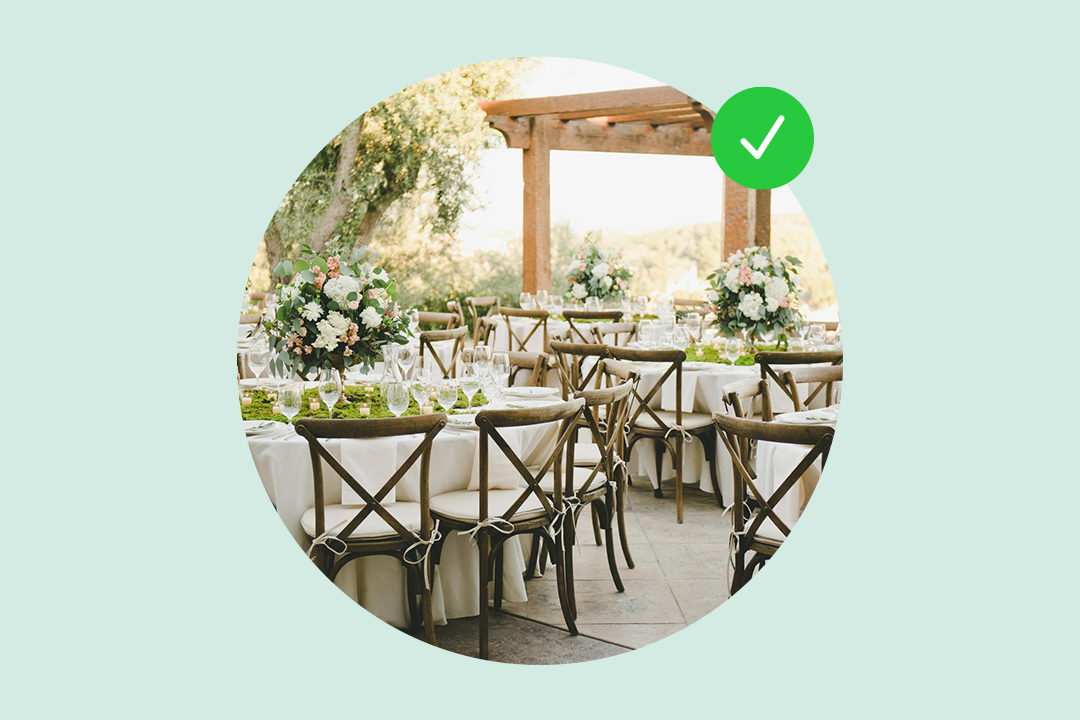- Expert advice/
- Wedding planning 101/
- Wedding planning tools/
- The Ultimate Guide for LGBTQ+ Wedding Planning
- Wedding planning tools
The Ultimate Guide for LGBTQ+ Wedding Planning
Tips for helping you get organized for your big day, keeping your needs as an LGBTQ+ couple in focus.
Last updated February 5, 2024

As if planning a wedding isn't hard enough, there are things that queer couples may consider while planning a gay wedding or have to think about during their journey that straight couples may not.
You should choose whether you want to be open about your sexual orientation with your vendors, whether or not you want to work with LGBTQ+ businesses, and how you will deal with stressful social situations with your wedding party, and friends and family as they may arise (for example, you may have a less informed family member ask intrusive questions like “how do gay weddings work?” or “are gay wedding plans different from straight wedding plans?”). Other tasks, such as choosing a venue, selecting a wedding photographer for wedding photos, narrowing down a timeline and a budget, and making a guest list are just some of the things that will need to be crossed off your wedding planning do-list.
And if you don’t have a wedding planner (and even if you do!), all of it can feel overwhelming.
But we’re here to help! Whether you’re planning a gay wedding, a same sex wedding, or another LGBTQ+ ceremony, here are all the tips and gay wedding ideas you need to get organized for your special day—while also keeping your needs as an LGBTQ+ couple as a focal point of your wedding planning. (Consider this your go-to gay wedding checklist!)
Let’s jump right into everything LGBTQ+ couples need to know to plan the perfect wedding:
1. The Proposal
You can’t start planning a wedding before you’ve agreed to get married—which is why wedding planning actually starts with the proposal.
When it comes to proposing, you can keep it traditional and propose to your partner—or you can opt for a dual proposal, which has become increasingly popular in the LGBTQ+ community. (With a dual proposal, both members of the couple propose at the same time—or, if the proposal is a surprise for one person, they might say “yes” and then propose to their partner at a later date).
Just make sure that, before you propose, you take care of the logistical details—like choosing the perfect location and getting the engagement rings. Depending on your and your partner’s preferences, you may opt for a private proposal or invite your friends and family to share in your big moment.
2. Have a Timeline for the Wedding
Coming up with a timeline for the wedding and ceremony will play a huge role in planning it, and it’s something that every couple goes through. Picking the time of year and date is the first big decision. From there, you can start to plan for a morning, afternoon, or evening wedding reception and ceremony and the location. Once you have these details down, you can start to tackle the other aspects of your reception and ceremony—and create an actual wedding timeline.
Your wedding timeline should include a complete list of everything that’s going to take place on your wedding day—and when and where each of those things are going to happen. Depending on your wedding, this might include:
- Getting ready
- Vendor arrivals (for example, the photographer, videographer, caterer, etc.)
- Wedding photos (including first look, bridesmaids and groomsmen photos, family photos, etc.)
- The ceremony
- Cocktail hour
- Reception
- First dance
- Speeches
- Meal (if a meal is being served at the reception)
- Cutting the wedding cake
- The couple’s exit
Need more insights on how to craft a thorough and effective timeline? Check out Your Ultimate Wedding Planning Checklist & Timeline

3. Have a Budget
Deciding on how much you can/want to realistically spend on your wedding is one of the most important details to nail down early. Knowing what your budget is can help give you a realistic picture of what your wedding will look like, and it can also help you decide where you want to spend the most money. Perhaps you want to spring for a larger venue, or maybe you’d rather spend more on food or decor—it’s easy to daydream until you’ve made definitive money decisions. Once you nail down the numbers, you and your partner can focus on the bigger details of the wedding.
Need more guidance on creating (and sticking to!) a budget for your big day? Check out How to Set Your Wedding Budget
4. The Invitations
You need to invite wedding guests to your big day. And that’s why a crucial part of planning an LGBTQ+ wedding? Creating your wedding invitations.
Your wedding invitations need to feature all of the details your guests need to RSVP and, ultimately, attend your wedding. This includes your and your partner’s name; the date, time, and location of your wedding; and details on how to RSVP. If you have a wedding website, you can also include a link on your invitation.
There are a ton of wedding invitation templates out there—but as an LGBTQ+ couple, you may need to change the wording to accurately reflect your partnership (for example, by using gender neutral pronouns for non-binary couples).
Once you’ve got your invitation wording and design down, you’ll want to get your invitations printed and send them to your guests well in advance of your big day. (Aim to send invitations six to eight weeks before your wedding. If you’re hosting a destination wedding or have a lot of guests that will need to travel, you may want to send out invitations earlier to give people time to arrange their travel plans.)
Need more invitation insights? Check out LGBTQ+ Wedding Invitations 101
5. The Outfits
You want to look your best on your wedding day—and so an important step in planning your wedding? Choosing your wedding attire.
When it comes to LGBTQ+ weddings, you have a ton of options. You can choose to go with the more traditional attire for your gender (like a wedding dress or suit) or wear something less traditional. Whatever makes you feel your best is what you should wear!
One thing to keep in mind? Whatever you and your partner decide to wear, it should go together. It doesn’t have to match, necessarily (for example, if you’re a gay couple, you don’t need to wear matching suits), but it needs to be visually cohesive. (So, you might choose to wear suits in complimentary colors or rock matching bowties and other accessories).
Also, don’t leave finding your outfit to the last minute! Make sure to lock in your wedding attire at least a month before your wedding; that way, there’s time for any alterations you need for your outfit to fit perfectly.
Need more outfit inspiration? Be sure to check out LGBTQ+ Tips for Styling Two Dresses Together and LGBT+ Tips for Styling Two Suits Together
6. Find an Inclusive Venue
Finding a wedding venue is another important element that will play a role in the ceremony and reception. As you are looking for a venue, deciding what you want as a couple is important, therefore getting on the same page is essential. From there, you can start to narrow it down, and planning a wedding is expensive. Wedding Wire's report from 2020 found that in 2019, the average cost of a venue was $10,500.
While it’s illegal in most states to discriminate against someone because of their sexual identity, sadly, it does still happen. When you’re choosing a wedding venue, you want to feel as comfortable and inclusive as you can there. Picking between hosting your wedding at a venue that has had LBGTQ+ weddings before and can accommodate you versus one that fully embraces and celebrates what it means for you and your partner makes all the difference in the world.
Need more tips for finding the perfect space for your wedding? Check out How To Choose A Wedding Venue
7. Find Vendors With Vision

From picking the food, furniture, and flowers, no matter how you cut it, vendors play a huge role in wedding receptions and ceremonies. Finding vendors that are the best fit for you, are LGBTQ+ friendly wedding vendors, and embrace supporting LGBT weddings can also take a little time. People from events management companies, florists, and caterers will work closely with you throughout planning your perfect wedding. They will get to know you and vice versa, and you will develop a working relationship with them.
As a result, the topic of being open about you and your partner's sexual and/or gender identity may come up. Whether you’re an openly same-sex couple, gay couple, trans couple, or identify as something else, it’s up to you how you choose to disclose or not disclose this information.
How you choose to handle this is up to you and your partner, and this is not the “right” or “wrong” way to do so. It’s about what makes the most sense for you and what you’re both most comfortable doing. Being open about who you are and the role this plays in your ceremony may be important to you, so letting your vendors know this upfront can help them.
Another avenue to pursue is finding queer owned and operated wedding vendors. Doing some research to find queer owned and operated vendors that are local to you can help the planning process be as seamless as possible if you choose to go this route. This can allow you to feel the most comfortable and also ensure that you are also working with people who have your needs in mind (and are a part of the LGBTQ+ community). Working with queer-owned wedding vendors will also allow you to support the queer community.
Need tips on finding LGBTQ+ vendors for your big day? Then check out our guide on How to Find LGBTQ+ Wedding Vendors
8. Make the Ceremony Your Own
When you're planning your wedding ceremony, there are a lot of things to think about. While it generally consists of exchanging rings and vows, there are lots of ways to make the experience your own through music, readings, and even thinking about the kind of entrance you want to make. First, decide on the location and also who will officiate the wedding are the biggest ones. Are you and your partner more traditional, or would prefer to be a bit more creative about it? Whether your ceremony is religious or non-denominational is up to you and there are lots of ways to go about it.
Getting clear on what kind of ceremony you want can help make other decisions a little easier, too. If you’re going the less traditional route and aren't having a religious ceremony, this can leave lots of options open for you. Thinking about who will officiate your wedding is something you’ll want to determine ahead of time. If it’s a justice of the peace or someone from your house of worship, making sure that you book your officiant ahead of time is important.
Think about readings (religious or otherwise) that have meaning for you. Perhaps there is a certain poem or even lyrics from a song that has the sentimental and personal meaning that can be incorporated into the ceremony.
Also, don't forget your vows. Many couples choose to write down their “I do’s,” which can be very moving and romantic. If you go that route, speaking from the heart is always your best bet. And, now with the fight for marriage equality and same-sex marriages have been legal for the past few years, being able to say them publically in a ceremony like your wedding makes it even more special!
There are also lots of ways to make a big entrance, and it will make the ceremony memorable in another way. Maybe you want to come in together as a couple. Or, sometimes you can go down the aisle separately, and perhaps you can be accompanied by a family member or close friend. Another option is to have one partner wait at the front where the ceremony will happen and the other person will walk down the aisle. You can also make an entrance down a separate aisle and meet at the front.
Looking for more tips on how to personalize your ceremony? Head over to LGBTQ+ Wedding Traditions & How to Reinvent Old Ones and 8 Gender-Neutral Readings for Your LGBTQ+ Wedding Ceremony
9. Personalize Your Reception
This should be one of the best parts of your wedding day. Everyone you love, regardless of familial relationships, or if they are your chosen family and friends, is there to celebrate you. When it comes to the reception, have fun, and don't be afraid to shake things up.
For example, instead of having a seating chart, encourage guests to find their seats. You can go all out with personalized details for both the reception and ceremony in terms of the décor to make it stand out more. Think about incorporating both you and your partner's favorite plants and flowers into the floral arrangements. Fun signs can also add a personalized touch, as well as photos of you and your partner throughout the venue. Rainbow-themed elements, if that's your style, can even make an appearance. Try to capture your style and flair as a couple, and be open about who you both are. Celebrating your new life is what's most important.
Planning a wedding for you and your partner that is true to who you both are is everything. And having people who are there to love and support you is also what's most important. Honoring who you are as a couple and the love you have for one another is what a wedding is all about, and all of the details that come up in the planning of it will help make this a day to remember.
Looking for more reception tips? We can help! Check out 20 Ideas for Your LGBTQ+ Wedding
Up next for you

How to Get Married in New York City: A Complete Guide
How To
From how to get a marriage license to picking the perfect venue, find out everything you need to know to plan the perfect New York wedding.

LGBTQ+ Wedding Traditions—How to Reinvent Old Ones
How To
One of the best parts of modern marriages is being able to pick and choose what wedding traditions you want to keep, change, or forgo. Here’s everything LGBTQ+ couples need to know about selecting traditions when wedding planning.

Wedding Vendor Checklist
How To
The vendors you choose can make or break your dream wedding. Want to know what to include on your wedding vendor checklist? This guide has you covered.
- Expert advice/
- Wedding planning 101/
- Wedding planning tools/
- The Ultimate Guide for LGBTQ+ Wedding Planning
Find even more wedding ideas, inspo, tips, and tricks
We’ve got wedding planning advice on everything from save the dates to wedding cakes.
